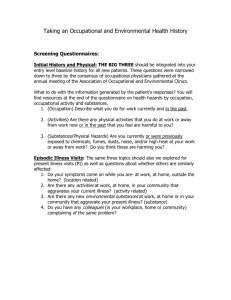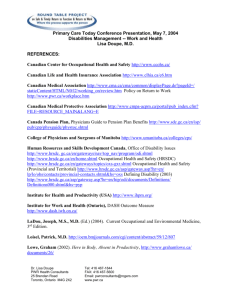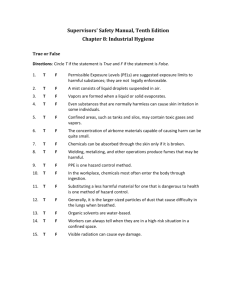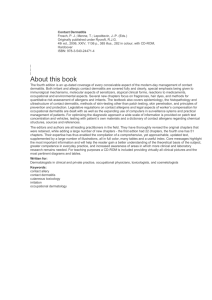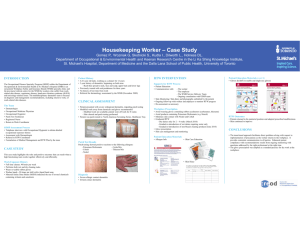Occupational Health Risks: Boilermakers
advertisement
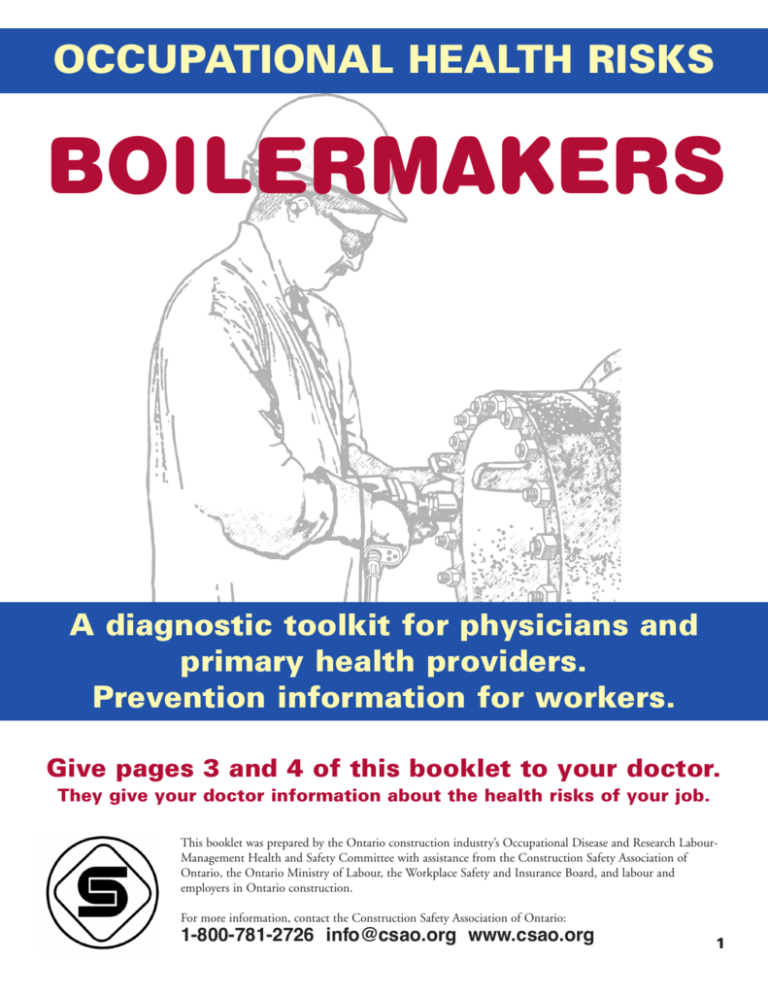
OCCUPATIONAL HEALTH RISKS BOILERMAKERS A diagnostic toolkit for physicians and primary health providers. Prevention information for workers. Give pages 3 and 4 of this booklet to your doctor. They give your doctor information about the health risks of your job. This booklet was prepared by the Ontario construction industry’s Occupational Disease and Research LabourManagement Health and Safety Committee with assistance from the Construction Safety Association of Ontario, the Ontario Ministry of Labour, the Workplace Safety and Insurance Board, and labour and employers in Ontario construction. For more information, contact the Construction Safety Association of Ontario: 1-800-781-2726 info@csao.org www.csao.org 1 FOR WORKERS Tasks and possible hazards All tasks ➤ dust on construction sites ➤ hazardous materials from industrial work sites (coke ovens, refineries, chemical plants, glass plants, factories, cement plants, pulp and paper mills, power plants). ➤ awkward postures, vibration, and hazardous noise while using power tools, grinders, saws, and mobile equipment. Installation, removal, or repair of equipment ➤ asbestos (could be part of the equipment— especially as insulation—or in building materials) ➤ lead ➤ solvents, adhesives, and epoxies ➤ liquids, sludges, or other materials on, in, or under equipment ➤ exhaust fumes from gas- or diesel-powered equipment. ➤ biological materials on equipment and in industrial plants. How to protect your health ✓ Ask your supervisor or employer for safe work instructions and training. ✓ Consult industrial clients on site-specific health and safety procedures. ✓ Ask about any hazardous materials or unknown chemicals when entering an industrial site for work. ✓ Ensure proper ventilation. ✓ Wear a proper respirator when ➤ you suspect asbestos may be a hazard ➤ working in dusty atmospheres ➤ welding ➤ using solvents, adhesives, or other hazardous substances ✓ Wear gloves, coveralls, welding jackets, or use barrier creams to protect the skin. ✓ Consult material safety data sheets (MSDSs) or information about hazardous chemicals used at work, and obey workplace health and safety rules. ✓ Never eat, drink, or smoke in areas contaminated with asbestos, lead, or toxic chemicals. ➤ lead ✓ Wash or wipe hands clean before eating, drinking, and smoking, and always clean up and remove contaminated clothing before getting in the car at the end of the shift. ➤ welding fumes, ultraviolet light, heavy metals, and chlorinated compounds ✓ Wash work clothes separately from casual and other family members’ clothes. ➤ dust from grinding activities. ✓ Report hazards to your employer. Welding, torch cutting, soldering, brazing, grinding For more information about health and safety in your job, contact your union or Construction Safety Association of Ontario: 1-800-781-2726, www.csao.org Ontario Ministry of Labour: 1-800-268-8013, www.labour.gov.on.ca Workplace Safety and Insurance Board: 1-800-387-5540, www.wsib.on.ca 2 FOR PHYSICIANS Occupational diseases and hazardous agents encountered by boilermakers and similar trades Asbestos-Related Diseases ■ Asbestosis, cancer (lung, mesothelioma, gastrointestinal)—asbestos ■ Cancer, continued ■ Leukemia—benzene ■ Skin—coal tar, ultraviolet light Asbestos warts—asbestos Neurological Respiratory Diseases ■ Asthma, occupational—fungi/mould, chromium, dust, epoxies, mineral fibres, PVC ■ Benign pneumoconiosis—welding fume ■ Bronchitis, chronic—organic dust, construction dust, welding fume, environmental tobacco smoke ■ Hypersensitivity pneumonitis (HP) acute/chronic—fungi/mould, wood dust Chronic bronchitis—ammonia gas Isocyanate HP—polyurethane foams, epoxy paints Metal fume fever—welding fume, iron, galvanized metal fumes Polymer fume fever—PVC, plastics, teflon Pontiac fever, Legionnaires’ disease— Legionella Pulmonary edema—cadmium, flux, solder, chlorine decomposition, silica Cancer ■ Lung—asbestos, coke oven emissions, diesel, dust, environmental tobacco smoke, silica, bioaerosols, nickel, hexavalent chromium ■ Hand-arm vibration syndrome—vibrating tools ■ Lead, subacute toxic effect—lead ■ Neuropathy, toxic—lead ■ Parkinsonism—carbon monoxide, manganese ■ Chronic solvent toxic syndrome—solvents, paints, degreasers, chlorinated solvents, thinners Skin Disorders ■ Dermatitis, allergic/contact—hexavalent chromium, coal tar, epoxies, paints, degreasers, glues ■ Contact urticaria—animal dusts Miscellaneous Disorders ■ Infertility, male—manganese, lead, chlorinated solvents, water-based paint solvents ■ Gastroenteritis—bacteria, animal waste ■ Hantavirus, histoplasmosis, leptospirosis, lymphocytic choriomeningitis—rodent/bird/bat droppings ■ Hepatitis (chronic solvent toxicity)—chlorinated solvents ■ Noise-induced hearing loss—noise, power tools, heavy machinery, grinders, industrial noise ■ Nasal—nickel, hexavalent chromium ■ Renal disease—cadmium, lead, degreasers, solvents ■ Gastrointestinal—asbestos, hexavalent chromium ■ Asphyxiation—work in confined spaces ■ Haematological/lymphatic—nickel, vinyl chloride, mineral wool The next page provides important diagnostic criteria for screening, early detection, and diagnosis. This information was prepared by the Ontario construction industry’s Occupational Disease and Research LabourManagement Health and Safety Committee with assistance from the Construction Safety Association of Ontario, the Ontario Ministry of Labour, the Workplace Safety and Insurance Board, and labour and employers in Ontario construction. ➤ 3 DIAGNOSTIC CRITERIA Asbestos disease Asbestos-caused fibrosis of the lungs and pleura may lead to shortness of breath. It usually takes 15 or more years from onset of exposure for radiographic abnormalities and symptoms to arise. Radiologists should be alerted to the suspected diagnosis. Boilermakers occupationally exposed to asbestos are at increased risk of cancers of the lungs and pleura. Screening for cancer is not recommended as screening has not been shown to reduce mortality. Asbestos-exposed workers should be counselled about smoking cessation. Occupational asthma Sensitizer-induced occupational asthma is caused by an immune response to specific workplace agents such as low-molecular-weight chemicals (such as diisocyanates, colophony [a pine resin product used in soldering] or epoxy compounds). Once a person has been sensitized to one of these materials, even exposure to extremely low quantities will exacerbate the asthma. If this form of occupational asthma is suspected from the patient's history, objective investigation is required to confirm or refute the diagnosis. Patients with confirmed sensitizer-induced occupational asthma should have no further exposure to the causative agent, since the best outcome is achieved with early diagnosis and complete avoidance of exposure. An objectively confirmed diagnosis is very important. Patients with suspected sensitizer-induced occupational asthma should be referred as soon as possible to a specialist (a respirologist, an allergist, or an occupational physician) with expertise in this area. Investigations are most helpful if they can be performed while the patient is still working in the suspected causative work area; the primary care physician may be able to initiate some of these. Ref: WSIB Website: http://www.wsib.on.ca/wsib/wsibsite.nsf/public/healthpocfoa Ref: Occupational asthma: an approach to diagnosis and management. Tarlo and Liss. CMAJ. 2003 Apr 1;168(7):867-71 Inhalation diseases: Welding fume fever & polymer fume fever Welding Fume Fever. A flu-like illness with a metallic taste in the mouth, throat irritation, and dry cough; Leucocytosis is common; normal chest x-ray. Occurs 3-10 hours after heavy exposure to zinc oxide fume or dust, e.g., after welding or flame cutting of galvanized steel. Resolves spontaneously within 48 hours. Polymer Fume Fever. A flu-like illness with chest tightness and mild cough occurring 4-8 hours after exposure to pyrolysis products of polytetrafluoroethylene (PTFE—trade names: Fluon, Teflon, Halon). There is leucocytosis but normal chest x-ray. Resolves within 48 hours. Contact dermatitis Contact dermatitis is an inflammatory skin reaction to direct contact with noxious agents in the environment. Substances that produce this condition after single or multiple exposures may be either irritant or allergic in nature. Irritant contact dermatitis (ICD) results from contact with external agents that directly damage the epidermis, in contrast to allergic contact dermatitis (ACD) in which the damage occurs through the host immune response as a result of a delayed type hypersensitivity reaction. The diagnosis of contact dermatitis should be considered when there is a suspected workplace agent (allergen or irritant). Screening should include determination of the following: A. Did the skin condition start after the worker started the job? OR Did the skin condition become worse after the worker started the job? AND B. Are symptoms better on weekends or holidays off work? Referral to a specialist with experience diagnosing and treating occupational contact dermatitis should be considered when any of the following are suspected: all cases of possible ACD; ICD with allergic features; chronic ICD; complicated ICD (e.g., not improving, deteriorating, confounded by another skin disease such as psoriasis). For more information, see the WSIB website: http://www.wsib.on.ca/wsib/wsibsite.nsf/public/healthpoccontactdermatitis Neurologic effects Acute toxic effect of solvents: Organic solvents are volatile substances commonly used in the workplace as cleaners and degreasers. The systemic symptoms of acute solvent poisoning resemble those of intoxication from alcoholic beverages. Toxic Neuropathy: Chemicals that can cause toxic polyneuropathy include lead and N-hexane. Most symmetrical, sensorimotor neuropathies caused by exposure to chemicals are indistinguishable from similar effects caused by systemic diseases such as diabetes or B12 deficiency. The diagnosis of toxic polyneuropathy is usually made on the basis of symptoms following exposure to the chemical and the resolution of symptoms months to years after cessation of exposure. For more info about occupational disease and workplace health and safety, contact the Workplace Safety and Insurance Board: 1-800-465-9646 April 2008 4

